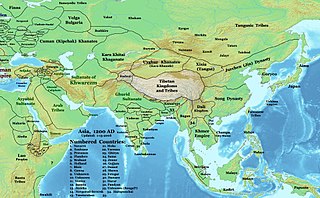| Rawatpura | |
|---|---|
| village | |
Chandela temple near Rawatpura lake | |
| Coordinates: 25°15′38″N79°39′46″E / 25.260687°N 79.662724°E Coordinates: 25°15′38″N79°39′46″E / 25.260687°N 79.662724°E | |
| Country | |
| State | Uttar Pradesh |
| Government | |
| • Body | Gram panchayat |
| Languages | |
| • Official | Hindi |
| Time zone | IST (UTC+5:30) |
| Vehicle registration | UP |
| Website | up |
Rawatpura is a tiny village 10 km east of Kulpahar, in the state of Uttar Pradesh, India. [1] It has many ruins of temples of the Chandela dynasty.

Kulpahar is a city in Mahoba district in the Indian state of Uttar Pradesh. It is a historical town in the Bundelkhand region. Before 11 Feb 1995 Kulpahar was a Tehsil of Hamirpur District. On 11 Feb 1995 Mahoba District was carved out of Hamirpur, and Kulpahar is now a part of the Mahoba District. Kulpahar is the largest Subdivision of Uttar Pradesh. Kulpahar is known for its closeness to Khajuraho and other historic places like Mahoba, Charkhari, Kalinjar Rath, Orchha, and Jhansi. This town holds relics of temples and man-made water bodies of the Chandela Dynasty.

Uttar Pradesh is a state in northern India. With over 200 million inhabitants, it is the most populous state in India as well as the most populous country subdivision in the world. It was created on 1 April 1937 as the United Provinces of Agra and Oudh during British rule, and was renamed Uttar Pradesh in 1950. The state is divided into 18 divisions and 75 districts with the capital being Lucknow. The main ethnic group is the Hindavi people, forming the demographic plurality. On 9 November 2000, a new state, Uttarakhand, was carved out from the state's Himalayan hill region. The two major rivers of the state, the Ganga and Yamuna, join at Allahabad (Prayagraj) and then flow as the Ganga further east. Hindi is the most widely spoken language and is also the official language of the state.

The Chandelas of Jejakabhukti were a royal dynasty in Central India. They ruled much of the Bundelkhand region between the 9th and the 13th centuries.


